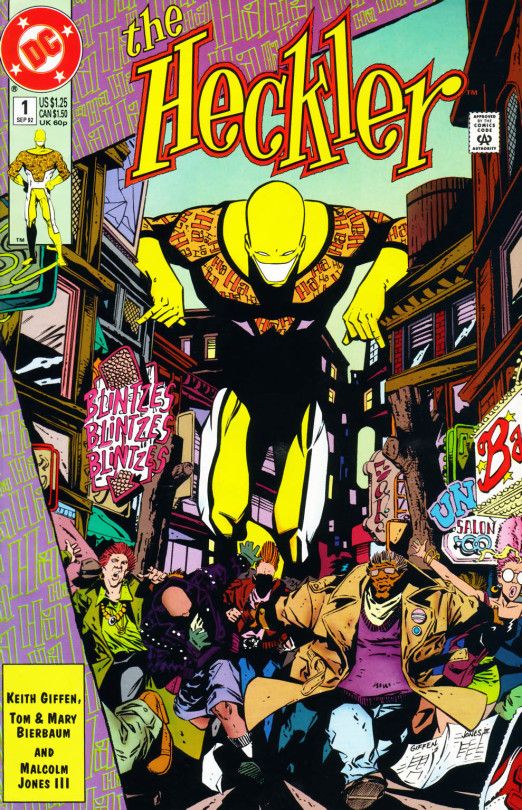
The Heckler comic introduces one of the most delightfully bizarre characters to ever grace the pages of DC Comics. Debuting on July 21, 1992, The Heckler burst onto the scene armed not with super strength or flight, but with a razor-sharp wit and an unyielding dedication to annoyance. This short-lived series, a passion project from the minds of Keith Giffen and Tom and Mary Bierbaum, stands as a cult classic for its sheer absurdity and its commitment to comedy over cosmic crises. It carved out a unique corner of the comic book world that few other titles have dared to explore.
The man behind the garish mask is Stuart “Stu” Moseley, the co-owner of “EATS,” a humble diner located in the crime-ridden ghetto of Delta City. By day, Stu is an anxious, somewhat awkward everyman. However, when night falls and injustice calls, he transforms. Donning his vibrant costume, he becomes The Heckler, a relentlessly confident and endlessly chatty vigilante. His main strategy isn’t to overpower his foes but to irritate and mock them into submission. In essence, he operates like a real-life cartoon character, reminiscent of Bugs Bunny, using clever tricks and psychological warfare to make his enemies defeat themselves. This approach makes The Heckler a fascinating study in what it means to be a hero in a world already saturated with them.
What Made The Heckler Comic So Unique?
The core appeal of The Heckler comic lies in its complete subversion of superhero tropes. In an era dominated by gritty anti-heroes and epic crossovers, The Heckler was a breath of fresh, chaotic air. The creative team leaned heavily into satire. Published by DC Comics, the series felt more like an indie darling, prioritizing sharp dialogue and outlandish scenarios over universe-shattering stakes. The Heckler has no tragic origin story or deep-seated trauma fueling his crusade; he seems to fight crime simply because he finds it amusing and is a glutton for punishment.
This satirical tone extends to the entire setting of Delta City and its cast of characters. The criminals The Heckler faces are just as goofy as he is. Instead of megalomaniacal world conquerors, he squares off against villains like Boss Glitter, a mobster obsessed with all things shiny, and PC Rabid, a gun-toting vigilante with extremist views on political correctness. This rogue’s gallery was designed to be more laughable than terrifying, allowing the comedy to always remain front and center. The series never took itself seriously, and that was its greatest strength.
The creative team behind this masterpiece of madness was:
- Plot/Pencils: Keith Giffen
- Script: Tom & Mary Bierbaum
- Inker: Malcolm Jones III
- Colorist: Tom McCraw
- Letterer: John Costanza
- Editor: Kevin Dooley
The Rogues Gallery of Delta City
You can’t have a hero without memorable villains, and The Heckler delivered some of the strangest in the history of comics. One of his primary antagonists was the aforementioned Boss Glitter, whose criminal empire was as flashy as his name. Then there was The Minx, a femme fatale whose motives were as confusing as her actions. Others included the bizarre holiday-themed “X-Mas,” the religious parody duo of Rabbi Zone and his Golem, Dreidel, and the hyper-patriotic Lex Concord. Each foe allowed the creative team to satirize different aspects of society and comic book clichés, from consumerism to fanaticism. These villains were never a true physical threat to The Heckler, but they provided the perfect foils for his incessant heckling and elaborate pranks. The design of each character, often sporting a ridiculous but memorable look, added to the visual humor that defined the series, making the comic book covers and interior pages a visual treat. While you may not find these characters in mainstream discussions, they hold a special place for fans who appreciate the stranger side of superhero storytelling. For those looking to dive into something different after reading about the latest releases, exploring older, more obscure titles like this can be a rewarding experience when compared to some new comics.
In conclusion, The Heckler comic remains a beloved oddity in the vast DC Universe. Its focus on witty banter, slapstick action, and satirical villains set it apart from anything else on the stands in the early ’90s. While Stu Moseley never achieved the fame of Batman or Superman, his brief, six-issue run left an indelible mark on readers who appreciated its wild, comedic energy. The Heckler proved that a hero doesn’t need immense power to make a difference—sometimes, all you need is a loud mouth and a total lack of shame.
What did you think of this issue? Join the conversation on X and tag us @comicbookaddt!
Find us on our other social media platforms:



